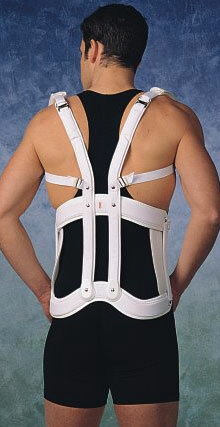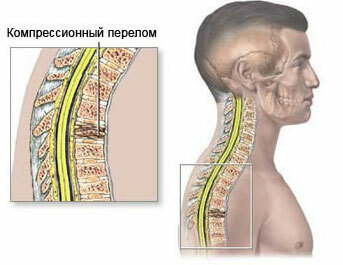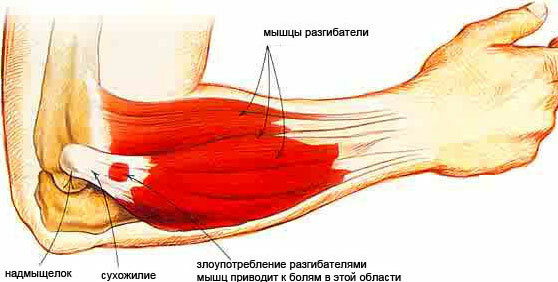These disorders can occur with a direct injury to the spine or under the influence of a certain force, causing its excessive and sharp flexion.
Causes of compression fracture of the spine
Compression fracture of the spine occurs as a result of excessive pressure on the body of the vertebra.
The most common compression fracture occurs in the lumbar and thoracic spine.
The body of the vertebra in the compression fracture takes the form of a wedge directed by the apex forward.
The inner tissues of the vertebral body are deformed and destroyed.
Compression fracture can occur with a large axial load during the inclination of the spinal column forward, which can often be seen when jumping to the feet from a high altitude.
The main causes of compression fracture of the spine:
- excessive weakness of the spine while maintaining normal axial loads;
- excessively sharp flexion-extension movements at high load;
- Osteoporosis.
Degree of gravity of the compression fracture of the spine
There are three degrees of severity of the spinal deformity:
I degree - the height of the affected vertebra is reduced by less than one third.
II degree - the height of the affected vertebra was reduced by 33-50% in relation to its original state.
III degree - the height of the affected vertebra was reduced by more than 55%.
The greatest severity is the comminuted fracture, which differs from the wedge-shaped( normal) fracture of the vertebral body.
Some breakaway fragments can damage the spinal cord or adjacent intervertebral discs.
If the first degree of compression fracture allows for conservative treatment, then the third degree will require surgical intervention.
Uncomplicated compression fracture of the spine is distinguished by the absence of any damage to the spinal cord.
This type of fracture can be successfully treated with osteopathic methods, completely restoring the work of the musculoskeletal system.
Symptoms of compression fracture of the spine
First signs of fracture:
- sharp pains in the legs;
- in the hands;
- in the vertebral region.
In addition, you can feel numbness and weakness( if the nerve endings of the spine are damaged).
With gradual destruction of the spine( with osteoporosis), the pain grows gradually and is usually moderate.
With a more severe form of compression fracture, adjacent areas of the body can be displaced into the spinal canal, exerting excessive pressure on the tissues of the spinal cord.
However, this happens rarely enough.
Diagnosis of compression fracture of the spine
Before starting the diagnosis, the physician collects all complaints of the patient and opens the history of the illness( anamnesis).
It is very important to find out the main cause of the fracture and differentiate it from other types of diseases that provoke pain in the back or in the spine.
After this, the doctor appoints a diagnostic complex to clarify the cause of the disease and choose the tactics of treatment.
The roentgenography of the spinal column is performed in two projections( lateral and direct).It allows you to identify the damaged vertebra.
Neurological examination is a test of the functionality of peripheral nerves, nerve roots, as well as the spinal cord.
After the radiography, the doctor usually prescribes a CT scan to study the damaged vertebra more closely.
In parallel with CT, myelography is performed to evaluate the actual state of the spinal cord at the site of the fracture.
If suspected of vertebral nerve damage, an MRI is usually performed.
All women who are already 50 years of age and who have a compression fracture of the spine should go through densitometry to detect osteoporosis.
Compression fracture of the spine in children is very important in time to treat, as further deformity of the spinal column will most likely lead the child to complete paralysis of the limbs and, consequently, to disability.
Treatment of compression fracture of the spine
After establishing the correct diagnosis, the right treatment is prescribed.
Compression fractures of the spine require:
- self-discipline;
- compliance with bed rest;
- continued treatment.
Treatment is mandatory under the supervision of a physician who prescribes the necessary procedures and medications.
The treatment method is chosen depending on the condition of the victim and the degree of severity of the fracture.
In the treatment of compression fracture of the spine, three main directions are distinguished:
- conservative treatment;
- vertebroplasty;
- kyphoplasty.
Conservative treatment of
 This type of treatment requires the following procedures:
This type of treatment requires the following procedures:
- analgesic therapy;
- temporary fixation of the spine with a special corset;
- is assigned special gymnastics and sparing gymnastics;
- special massage;
- is prescribed physiotherapy.
In addition, the patient can be offered a corset with a compression fracture of the spine, which will additionally fix the axis of the spine and spread the site of its fracture.
Terms of wearing a corset vary and range from one to two months.
If necessary, it is possible to manufacture a corset to order.
Conservative treatment for the first time implies putting the patient on a hard, sloping bed.
This excludes any physical activity.
Over time, a physician can prescribe exercise therapy that will help:
- create a muscle corset that holds the spine in its normal position;
- restoration of normal mobility and flexibility of the spine;
- strengthening of long back muscles;
- restoration of the correct axis of symmetry and the natural shape of the spine.
The usual time to restore the patient's workability is four to five months.
Vertebroplasty and kyphoplasty
Vertebroplasty and kyphoplasty are minimally invasive methods of treatment.
Video: Vertebroplasty procedure
With vertebroplasty on the skin, a small incision is made to insert the needle.
This operation is carried out under fluoroscopic control.
A special cement slurry enters the injured vertebra through the needle into the injured vertebra, which further prevents its complete destruction.
The operation of vertebroplasty allows:
- to strengthen the vertebra in its place;
- to eliminate back pain.
Kyphoplasty is designed to correct the shape and position of the injured spine.
To the damaged vertebrae, through several small incisions from different sides, two needles are inserted, which make two small holes in the vertebrae to insert two deflated chambers.
Cameras are inflated, restoring the normal form of the vertebra.
After this, the vertebra is fixed with bone cement in the required position.
Surgical treatment of patients with chronic compression fracture of the spine is performed under more difficult conditions, and is much more difficult for patients.
Diet in the treatment of compression fracture requires taking products enriched with:
- silicon;

- by magnesium;
- with calcium.
In addition, the dietary diet of the patient should contain more:
- boiled fish;
- nuts;
- persimmon;
- milk;
- of green vegetables;
- rose hips;
- bread with bran;
- cauliflower;
- olives;
- turnips;
- radish;
- of black currant;
- infusions yarrow, nettle, mother-and-stepmother.
Rehabilitation after compression fracture of the spine
Rehabilitation of the patient in the absence of nerve damage poses the main goal - gradually mobilize the patient.
For this, basically, physiotherapy is applied, which can be started 45-50 days after the fracture.
For pain relief, apply:
- massage;
- cold therapy;
- electrostimulation.
Physiotherapy helps:
- restore vertebral flexibility;
- to increase their mobility;
- restore the correct posture.
Consequences of compression fracture of the spine
The danger of compression fracture is:

- development of instability in the injured spine;
- kyphoscoliosis( persistent curvature of the spinal column);
- osteochondrosis;
- radiculitis.
Bone fragments, pressed into the body of the vertebra, contribute to the gradual narrowing of the spinal canal, transmitting blood vessels that nourish the nervous structures.
The result is a violation of the blood supply to the spine, which is called - stenosis of the spinal canal.
Reducing muscle strength, numbness of certain body parts and pain during stenosis develop gradually, which again reminds us of the need for an urgent visit to the doctor.
Of particular importance in this case is the timely detection of compression fracture of the spine and the beginning of its full treatment.
Take care of yourself.
Stay healthy!
Video: Rehabilitation after a fracture of the spine
 A vertebral fracture is a pathological condition that occurs as a result of a violation of the integrity of the bone system of the spine.
A vertebral fracture is a pathological condition that occurs as a result of a violation of the integrity of the bone system of the spine.



